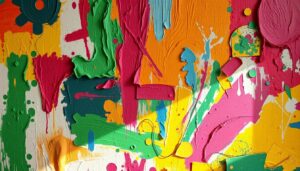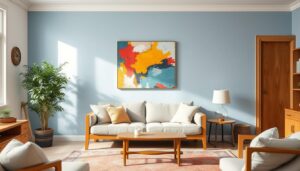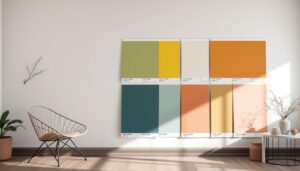Did you know that artists have been using unconventional tools, like cotton buds, to create textured wall painting techniques that date back to the Paleolithic era? These small but mighty tools bring a myriad of possibilities to your walls.
Innovative Painting Techniques to Add Texture and Depth to Your Walls are redefining the way you can transform interior spaces. In an era where dimensional wall art is more popular than ever, embracing these methods can reflect your personal style and enhance the overall ambiance of a room. Moving beyond traditional flat painting, modern techniques allow you to incorporate various textures and finishes that can elevate the aesthetics of any environment. The shift towards textured wall painting not only adds depth but also invites a tactile experience that draws the eye and elicits emotion.
Key Takeaways
- Utilizing cotton buds for detailed painting techniques can yield stunning results.
- Innovative methods, such as marbling and fresco, enrich the character of your walls.
- Texture plays a crucial role in enhancing a room’s aesthetic and ambiance.
- Modern faux techniques prioritize eco-friendliness with water-based glazes.
- Understanding the application of various tools can lead to dynamic artistic expressions.
Understanding the Importance of Texture in Interior Design
Texture significantly affects your experience within a space. The importance of texture in interior design cannot be overstated, as it both influences emotions and stimulates creativity. For instance, a room’s atmosphere can transform through the integration of varying wall textures and other tactile elements that encourage engagement.
There are two primary categories of texture in interior design: tactile and visual textures. Tactile textures include materials like velvet, denim, and plush carpets that establish a comforting environment. Visual textures, encompassing colors, patterns, and materials, contribute deeply to a room’s aesthetic appeal. By combining these textures effectively, you can create an inviting ambiance that resonates with personal style.
Incorporating various textures offers multiple methods to enhance a space. Consider using plants, 3D art, and decorative wall coverings to introduce textural diversity. In particular, textured wall coverings like grasscloth or cork contribute to visual interest, while layerable textiles such as jute rugs and silk draperies provide depth. Architectural features such as crown molding and wainscoting further enrich your design by adding character.
Lighting also plays a crucial role in emphasizing texture. The interplay of light and shadow can create captivating visual effects, enhancing the atmosphere of your rooms. For example, different light bulb colors and lamp styles affect how textures appear, impacting the overall design.
Experimenting with a variety of materials like wood, stone, fabric, and glass creates a diverse palette of textures that contribute significantly to the overall design. The successful application of textures in your home decor not only establishes a unique character for the space but also promotes a sense of warmth and comfort.
| Type of Texture | Examples | Impact on Design |
|---|---|---|
| Tactile Textures | Velvet, denim, carpets | Creates warmth and invitation |
| Visual Textures | Colors, patterns, materials | Enhances aesthetic appeal and depth |
Embracing the importance of texture in your interior design journey allows you to establish a theme that embodies your unique style, whether contemporary, rustic, or industrial. A well-considered mix of textures will invite interaction, engagement, and a sense of home.
What Are Innovative Painting Techniques?
Innovative wall painting techniques transform spaces and elevate interior design. These methods go beyond conventional painting, using modern painting techniques that introduce unique patterns, textures, and colors to your walls. The focus on painting techniques for depth allows you to enrich your living environment, whether aiming for a subtle elegance or a striking boldness.
Among the innovative techniques, you will find methods designed to create visually dynamic effects. These include:
- Rag Rolling: This technique utilizes a slightly diluted paint to create fabric-like textures, resulting in dynamic swirling patterns on your walls.
- Color Washing: For a soft, layered look, this method uses a 1:1 ratio of paint and glaze, promoting depth through multiple shades.
- Stenciling: This approach allows intricate designs to be applied with precision using painter’s tape and stencil brushes, ideal for adding decorative accents.
- Strié: Thin vertical lines impart sophistication and texture, creating an upscale ambiance in any room.
- Sponging: By using a glaze mixture of one part latex paint to four parts glaze, this technique adds intricate textures that catch the eye.
These painting techniques cater to various styles, ensuring personalization. With over 70% of these innovative wall painting approaches focusing on textured effects, they can transform your walls into masterpieces while showcasing your personality.
Textured Finishes for Dimensions and Character
Textured finishes provide an excellent way to enhance the visual appeal of your walls, introducing both depth and character. These techniques allow for hiding minor imperfections, contributing to a flawless appearance. Beyond aesthetics, textured finishes can also enhance acoustics by minimizing sound reflections, which is particularly beneficial in rooms with high ceilings.
Venetian Plaster: A Touch of Elegance
Venetian plaster stands out as a classic method that originated in Italy, offering an elegant touch to any interior. By applying multiple layers of plaster, it achieves a polished and marbled effect, creating the illusion of both depth and sophistication. Expertly applied by professionals, including Dulux Accredited Painters, it becomes a stunning focal point in upscale environments. This technique not only elevates the décor but also reflects a commitment to quality and craftsmanship.
Suede Finishes: Soft and Cozy
For those seeking warmth and comfort, suede wall finishes are an excellent choice. This textured finish absorbs light, resulting in a soft ambiance that transforms spaces into inviting retreats. Particularly ideal for bedrooms and cozy nooks, suede finishes foster a sense of tranquility, making them perfect for areas designed for relaxation. The tactile quality resonates well with anyone looking to enhance their living environment with a touch of coziness.
Colour Washing for a Soft, Layered Look
The colour washing technique enhances walls by applying soft layered paint over a base coat. This method creates a subtle, gently blended finish reminiscent of watercolor art, adding depth and dimension to your interiors. It effectively achieves a worn, aged look that introduces character to spaces.
To successfully execute this technique, start with a base coat in a neutral or pastel tone. Next, mix a thinner layer of a complementary hue. Use a brush or roller to apply the colour washing, ensuring to blend it evenly. The result is a visually captivating textured wall painting that exudes warmth and elegance.
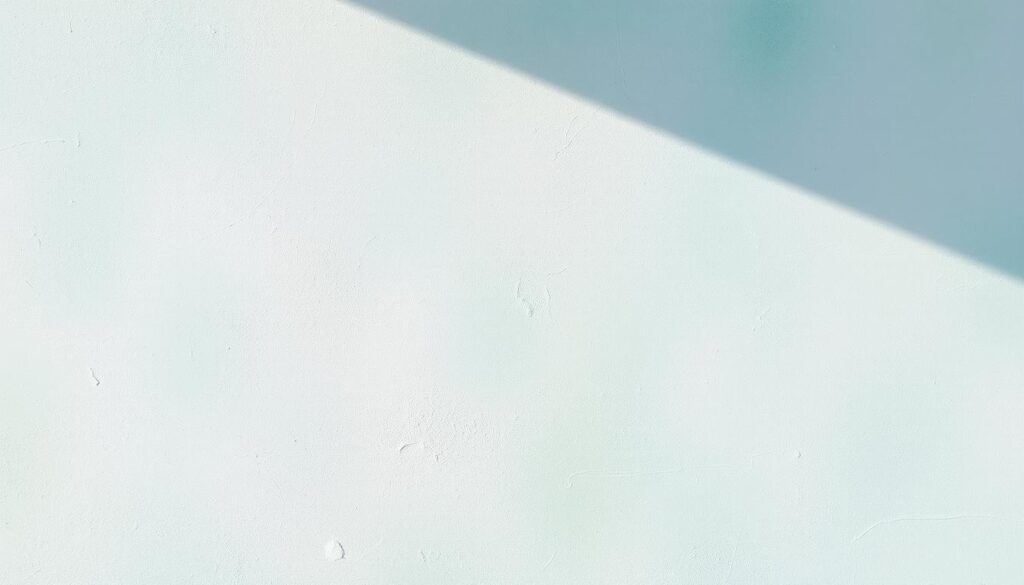
Colour washing can be particularly effective in rustic or vintage-themed rooms. The technique pairs beautifully with other decorative paint methods, such as sponging and rag rolling, which also add texture. Combining these methods allows for a unique aesthetic that transforms ordinary walls into an inviting backdrop for your home.
Experimenting with different colour combinations can yield varied results, so you can tailor the look to fit your personal style. Consider applying a lighter hue for a more subtle effect or a bolder colour for a stronger visual impact. In engaging spaces, this layering of soft layered paint will undoubtedly create a welcoming atmosphere.
Geometric Patterns to Enhance Modern Décor
Incorporating geometric patterns into your home décor can create a striking effect that captures attention. These designs have surged in popularity, transforming ordinary spaces into extraordinary ones. Geometric patterns in painting—utilizing squares, triangles, and lines—bring visual interest that is essential in modern interiors.
Creating Visual Interest with Shapes
Playing with shapes not only introduces modernity but also establishes a sense of order and balance in your space. Effective use of geometric patterns can significantly enhance your home’s aesthetic appeal. This trend is driven by a desire for harmony and structure found in contemporary design.
One effective way to integrate these patterns is through wall stenciling or using precise tape lines for a clean finish. Choices in colour, scale, and placement are vital, as these elements contribute to a cohesive and harmonious visual composition. For instance, bold colours can energize a room, while neutral tones provide timeless elegance.
- Consider warm neutral undertones for a cozy atmosphere.
- Cool undertones can promote a serene environment.
- Mixing geometric patterns allows for creative depth.
The spatial dynamics of your room can be influenced by the scale of the patterns you choose. Larger shapes can make a bold statement, while smaller patterns can evoke subtle beauty. This versatility in geometric designs can elevate your home’s modern décor, making it a space that reflects both style and personality.
| Pattern Type | Effect on Space | Ideal Colour Choices |
|---|---|---|
| Large Geometric Shapes | Creates dramatic focal points | Bold, vibrant colours |
| Small Geometric Patterns | Adds subtle texture and depth | Neutral tones with warm or cool undertones |
| Mixed Patterns | Enhances creativity and visual interest | Complementary colours or monochromatic schemes |
By thoughtfully selecting geometric patterns, you have the power to reshape the ambiance of your home. Whether it’s through painting techniques or textured finishes, embracing these designs leads to a modern and visually engaging space that resonates with contemporary styles.
Metallic Accents to Introduce Luxury
Incorporating metallic accents into your home can dramatically elevate its sophistication. Metallic painting techniques, including the use of glazes and paints, allow you to create striking contrasts against matte finishes. By highlighting architectural details, you can transform ordinary elements into luxurious features. These luxury wall finishes reflect light beautifully, enhancing the ambiance of formal areas such as dining rooms and bedrooms.
The use of warm metals like brass, copper, and bronze brings a touch of warmth and elegance, making it an ideal choice for a contemporary, luxurious feel. Investing in high-quality materials highlights the ethos of “simple luxury,” where subtle metallic accents, such as brushed gold and aged bronze, complement your overall design ethos. This approach emphasizes quality over quantity, ensuring that each element in the space adds to a cohesive look.
Consider layering textures to amplify the luxurious feel of your interiors. Combining plush textiles, natural woods, and metallic accents creates depth and richness, offering a contrast that is visually appealing. Statement lighting fixtures made from materials like marble and nickel can serve as focal points, tying together the various elements of your design.
The details matter. Attention to hardware and finishes can significantly influence the perception of luxury within a room. Incorporating statement artworks and mirrors using metallic accents can redefine the aesthetic, making the space feel more personal and inviting. As you explore the realm of luxury in interior design, let metallic accents guide your vision of elegance.
Eco-Friendly Paints for Sustainable Choices
The rising demand for eco-friendly paints reflects greater awareness of health and environmental impacts. When considering sustainable painting options, low VOC benefits play a crucial role, particularly in enhancing indoor air quality. You can achieve beautiful designs while making responsible choices for your home or workspace.
Benefits of Low VOC Paints
Low VOC paints ensure minimal emissions during the drying process. This leads to a healthier living environment, which is especially significant for households with children and pets. With virtually no toxic compounds, these sustainable painting options provide a safer atmosphere.
Water-based paints, made from biodegradable ingredients, are a prime example of eco-friendly paints. These alternatives to traditional non-water-based paints offer numerous benefits, including:
- Non-toxic formulation: Ideal for those sensitive to odors or with skin irritations.
- High-quality performance: Improved color retention and durability compared to chemical-laden counterparts.
- Environmental consideration: Contribute to better air quality and lower environmental impact.
Plant-based and mineral paints also serve as excellent options. These paints utilize natural ingredients like beeswax and clay, ensuring no harm comes to your indoor environment. They are exceptionally durable, resistant to mold, and often don’t require primers, making them user-friendly for both professionals and DIY enthusiasts.
Choosing eco-friendly paints not only adds beauty to your space but also aligns with a commitment to sustainability. This investment enhances your interior design while potentially earning a Green Star rating, reflecting a dedication to environmentally conscious living.
Murals and Large-Scale Graphics for Personality
Incorporating wall murals and large-scale graphics into your space can dramatically enhance its personality. These vibrant expressions of art allow you to create a uniquely personal atmosphere that reflects your style. Imagine transforming an uninspired wall into a stunning focal point with a breathtaking landscape or an abstract design that sparks conversation.
Wall murals are not just about aesthetics; they play a functional role. For instance, depth-enhanced murals can make smaller rooms appear larger, offering an illusion of space. Calming nature scenes can bring a serene ambiance, making your environment feel relaxed and inviting. With over 30,000 designs available from leading suppliers like Photowall, you will find something that resonates with your taste.
These large-scale graphics can serve many purposes beyond mere decoration. They often function as accent walls, establishing themes and motifs while incorporating elements of art and culture to evoke authentic feelings and moods. Whether your preference leans toward urban landscapes, whimsical fantasy themes, or nature-inspired murals, personalizing your wall art can significantly elevate your interior design.
Wall murals also extend to creative applications in arts and crafts. Think about using mural designs to embellish everyday objects like cabinets, lampshades, or notebooks, giving each item a pop of personality. This versatility makes personalized wall art ideal for both home and office environments, offering an opportunity to showcase your creativity.
Protection is yet another advantage of wall murals. They act as shields against wear and tear, especially in high-traffic areas, safeguarding your walls from scratches and dings. This makes them not only a beautiful choice but a practical one as well.
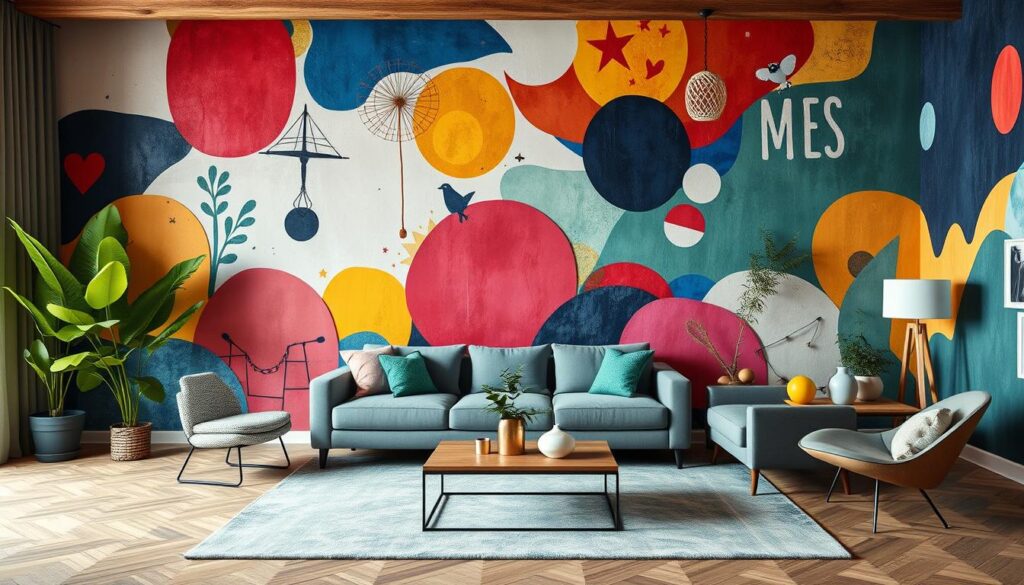
| Type of Mural | Common Themes | Benefits |
|---|---|---|
| Cityscapes | Urban landscapes, iconic landmarks | Creates a dynamic and energetic atmosphere |
| Nature | Tropical scenes, mountains, forests | Promotes tranquility and connection with nature |
| Abstract | Bold colours, expressive shapes | Encourages creativity and imagination |
| Fantasy | Mythical creatures, fairy tales | Brings whimsy and a sense of wonder |
| Animals | Wildlife, pets in artwork | Evokes emotional connections and warmth |
Chalkboard and Magnetic Paint for Fun Interactivity
Chalkboard paint introduces an interactive dimension to walls, enabling you to leave messages, lists, or personal artwork directly on the surface. This creative approach transforms any space into a canvas, perfect for family rooms, play areas, or home offices. Kids can unleash their imagination, encouraging both learning and play. The versatility of chalkboard paint allows for spontaneous expression, continually refreshing your room’s décor.
On the other hand, magnetic paint offers a unique functionality. It allows for the display of notes, photos, or artwork without damaging the wall. You can create dynamic interactive wall finishes, making it easy to change your display according to seasons or events. Combining both chalkboard and magnetic paint in a single area can further enhance the engagement, creating a vibrant and useful space.
Considering the practical applications of these paints, here are some key benefits:
- Encourages creativity and collaboration within the household.
- Helps to organize everyday tasks, keeping reminders visible.
- Offers a customizable surface that adapts to changing themes or décor styles.
- Provides easy clean-up options, especially with washable finishes.
When selecting paints, ensure they are safe, especially in children’s environments. Water-based and non-toxic options are advisable for health-conscious households. Using these interactive wall finishes not only enhances the aesthetic value of your space but also fosters an environment of imagination and functionality.
Overall, integrating chalkboard paint and magnetic paint into your home creates a fusion of art, education, and interactive fun, redefining how you engage with your living space.
Ombre Walls: A Unique Artistic Element
In recent years, ombre wall painting has gained significant popularity as an innovative way to enhance interior spaces. This technique creates stunning gradient wall effects, effortlessly blending colors from dark to light. Such a transition not only captivates the eye but also evokes a sense of calmness and elegance, especially in bedrooms and living areas.
The magic of ombre lies in its versatility. You can achieve anything from subtle transitions to bold contrasts, allowing for an artistic expression tailored to your preferences. This artistic wall finish can transform a plain room into a personalized masterpiece, combining color choices that reflect your unique style.
When selecting colors for ombre, a recommended palette usually includes a gentle shift from light to dark. For instance, a soft blue may transition to a deep navy or a soft pink may blend into a rich burgundy. This gradient wall effect not only creates visual interest but also adds depth to your space.
Incorporating ombre walls into your home offers an exciting way to explore artistic wall finishes. Embrace the trendiness of this modern technique to elevate your interior design, fostering an atmosphere of tranquility and sophistication.
| Aspect | Description |
|---|---|
| Visual Appeal | Creates an eye-catching gradient that draws attention. |
| Emotional Impact | Evokes feelings of calmness, perfect for restful spaces. |
| Versatility | Suitable for various room types, from bedrooms to living areas. |
| Color Choices | Options range from soft pastels to bold jewel tones. |
| Application Techniques | Can be achieved using sponges, brushes, or rollers for different effects. |
Innovative Painting Techniques to Add Texture and Depth to Your Walls
Exploring innovative painting techniques can open a world of possibilities for your walls. By combining various techniques, you can achieve unique wall finishes that reflect your personal style. Experimenting with different methods allows for the creation of layered wall textures, bringing depth and character to your interiors.
Combining Various Techniques for a Multifaceted Approach
Combining painting techniques such as rag rolling, sponging, and stenciling can result in captivating multifaceted wall designs. Each technique contributes its own texture and effect, transforming a plain wall into a stunning focal point. For instance, using a base coat with sponging techniques adds depth while stenciling introduces intricate patterns without requiring advanced skills. This creative layering enables an artistic expression that elevates any space.
Additionally, incorporating methods like colour washing and ombre techniques introduces soft gradients and subtle transparency to your walls. Imagine a beautiful transition of colors, enhancing the visual interest of your room. When you merge various painting styles, you can create an environment that is not only visually appealing but also deeply personal.
Layering textured finishes with geometric patterns further enhances the atmosphere of your space. Not only does this approach promote individuality, but it also ensures that each wall is a conversation starter. The beauty of combining painting techniques lies in the endless possibilities for customization, making every room a true reflection of your vision.
Conclusion
Exploring various innovative painting techniques reveals an array of possibilities for transforming your walls into intricate, textured masterpieces. From advanced methods like sponging, ragging, and stenciling to the allure of specialty finishes such as marbling and tropical landscape painting, you have the tools at your disposal to reflect your unique style. Understanding proper surface preparation is critical; it’s the foundation that leads to a flawless finish.
Your endeavors in wall painting not only focus on aesthetics but also enhance the overall mood of your interior spaces. By emphasizing the significance of color theory and selecting the right tools, you can create an inviting atmosphere that tells a story. In this innovative wall painting summary, remember that achieving a professional-quality finish involves knowing your paints—choosing low-VOC options can significantly improve your indoor air quality, making your home a healthier place to live.
Ultimately, whether you’re a novice or a seasoned expert, implementing these techniques will enable you to design walls that are not only visually stunning but also enduring. By applying these methods, you can truly elevate your interiors. Keep these final thoughts on textured walls in mind as you embark on your next painting project, ensuring your home reflects the beauty and character you envision.



